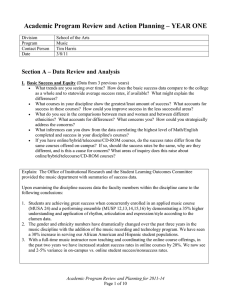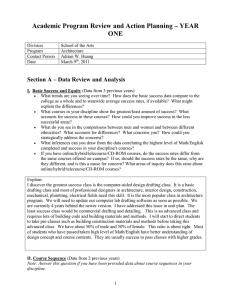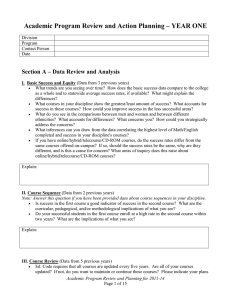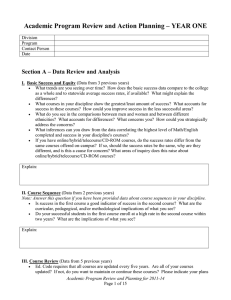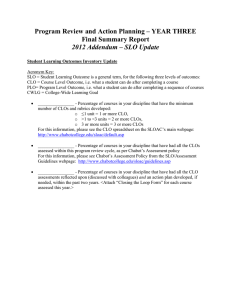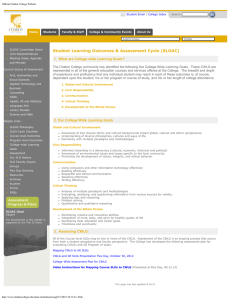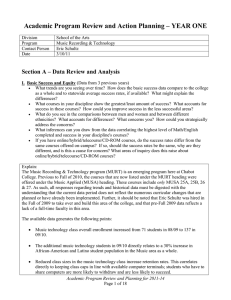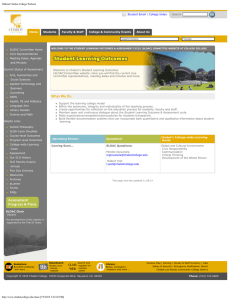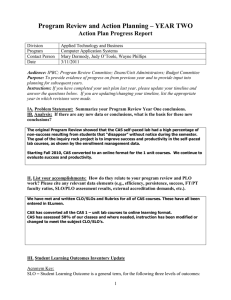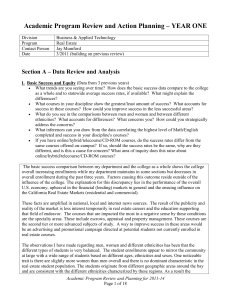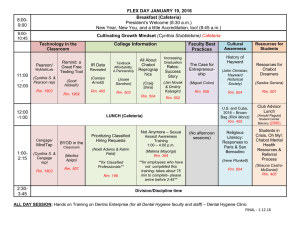Academic Program Review and Action Planning – YEAR ONE
advertisement
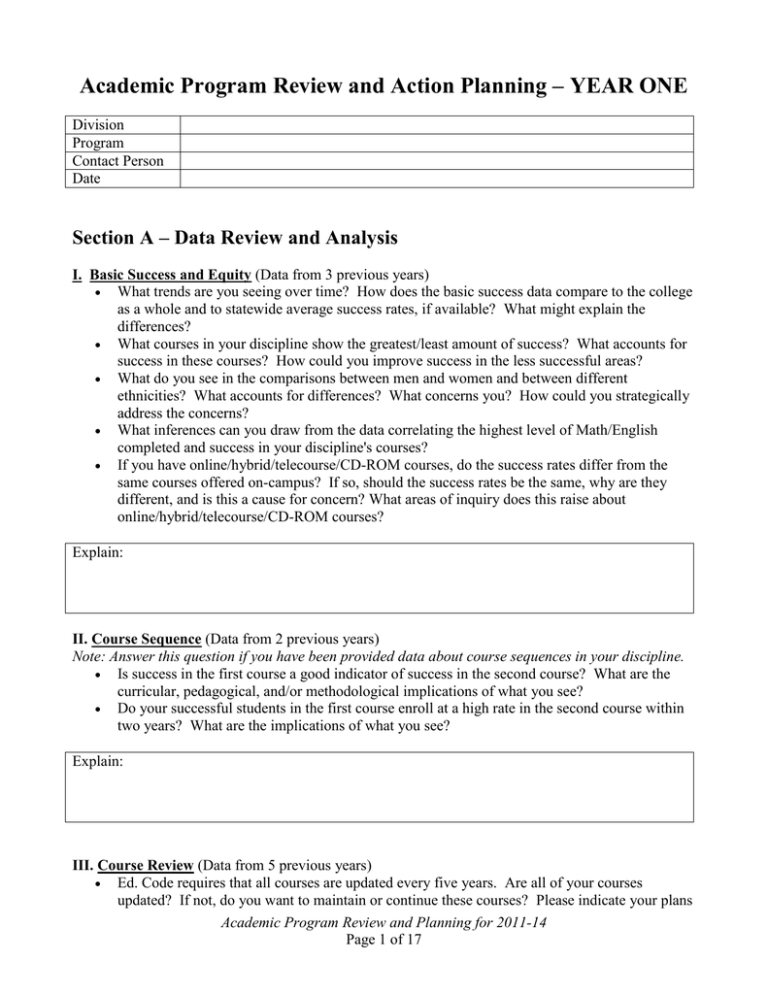
Academic Program Review and Action Planning – YEAR ONE Division Program Contact Person Date Section A – Data Review and Analysis I. Basic Success and Equity (Data from 3 previous years) What trends are you seeing over time? How does the basic success data compare to the college as a whole and to statewide average success rates, if available? What might explain the differences? What courses in your discipline show the greatest/least amount of success? What accounts for success in these courses? How could you improve success in the less successful areas? What do you see in the comparisons between men and women and between different ethnicities? What accounts for differences? What concerns you? How could you strategically address the concerns? What inferences can you draw from the data correlating the highest level of Math/English completed and success in your discipline's courses? If you have online/hybrid/telecourse/CD-ROM courses, do the success rates differ from the same courses offered on-campus? If so, should the success rates be the same, why are they different, and is this a cause for concern? What areas of inquiry does this raise about online/hybrid/telecourse/CD-ROM courses? Explain: II. Course Sequence (Data from 2 previous years) Note: Answer this question if you have been provided data about course sequences in your discipline. Is success in the first course a good indicator of success in the second course? What are the curricular, pedagogical, and/or methodological implications of what you see? Do your successful students in the first course enroll at a high rate in the second course within two years? What are the implications of what you see? Explain: III. Course Review (Data from 5 previous years) Ed. Code requires that all courses are updated every five years. Are all of your courses updated? If not, do you want to maintain or continue these courses? Please indicate your plans Academic Program Review and Planning for 2011-14 Page 1 of 17 in terms of curriculum. Have all of your courses been offered recently? If not, why? Are students counting on courses to complete a program or major when these courses are not being offered? Explain: IV. Budget Summary (Data from 3 previous years) What budget trends do you see in your discipline? What are the implications of these trends? Where is your budget adequate and where is it lacking? What are the consequences on your program, your students, and/or your instruction? What projected long-term (5-10 years) budget needs do you see? You will detail your short-term needs in the action plan that follows. You do not need to cite them here. Explain: V. Enrollment Data (Data from 2 previous years) Please provide a brief description of: overall enrollment trends; enrollment trends by course; and enrollment trends by time of day and Saturday. Describe what your discipline has done in terms of curriculum or scheduling in the last two years that has effected enrollments. Describe plans or strategies that you have for the near future in terms of curriculum or scheduling that could impact your enrollments. Lastly, look closely at whether the schedule you currently offer provides access to the broader community that your discipline serves at Chabot College—day time, night time, Saturday, distance education, special or targeted communities that would or do enroll in your courses. Explain: Academic Program Review and Planning for 2011-14 Page 2 of 17 VI. Student Learning Outcomes Inventory Acronym Key: SLO = Student Learning Outcome is a general term, for the following three levels of outcomes: CLO = Course-level Outcome, i.e. what a student can do after completing a course PLO= Program-level Outcome, i.e. what a student can do after completing a sequence of courses CWLG = College-wide Learning Goal Percentage of courses in your discipline that have CLOs and rubrics developed:_________ For this information, please see the list of which courses do and do not have CLOs on the SLOAC’s main webpage: http://www.chabotcollege.edu/sloac/default.asp Percentage of courses in your discipline that have the minimum number of CLOs developed: (1 unit = 1 or more CLO, 2 units = 2 or more CLOs, 3 or more units = 3 or more CLOs)_______ For this information, please see the CLO spreadsheet on the SLOAC’s main webpage: http://www.chabotcollege.edu/sloac/default.asp Date the CLO Assessment schedule was submitted:________ For this information, please see the Course-level Outcomes assessment schedules list from the Assessment Progress and Plans webpage: http://www.chabotcollege.edu/sloac/progress.asp Percentage of courses in your discipline that have had all the CLOs assessed within the past three years, as per Chabot’s Assessment policy: _______ For this information, please see Chabot’s Assessment Policy from the SLO/Assessment Guidelines webpage: http://www.chabotcollege.edu/sloac/guidelines.asp Percentage of courses in your discipline that have had all the CLO assessments reflected upon, or discussed with colleagues, within the past three years_______ What questions or investigations arose as a result of these reflections or discussions? Explain: What actions has your discipline determined that might be taken as a result of these reflections, discussions, and insights? Actions planned: What course-level and programmatic strengths have the assessment reflections revealed? Strengths revealed: Academic Program Review and Planning for 2011-14 Page 3 of 17 Percentage of programs within your discipline that have established at least two PLOs, and mapped appropriate CLOs to them:________ For this information, please see the Program-level Outcomes progress page from the Assessment Progress and Plans webpage: http://www.chabotcollege.edu/sloac/progress.asp Which of the CWLGs do your discipline’s CLOs address? ______________________________ ______________________________________________________________________________ In which if any of the College-wide Learning Goals Faculty Inquiry Groups have discipline member(s) participated? _________________________________________________________ ______________________________________________________________________________ Insights gained: VII. Academic Learning Support What kinds of academic learning support does your discipline use or require to help students succeed (e.g., tutoring, learning assistants, student assistants, peer advisors, lab support, supplemental instruction, peer-led team learning, peer advisors)? How many hours per semester do you use and/or how many hours per semester do you need? Explain: VIII. External Data Cite any relevant external data that affects your program (e.g., labor market data, community demand, employment growth, external accreditation demands, etc.). Academic Program Review and Planning for 2011-14 Page 4 of 17 Section B – Data Summary From what you have learned in your basic data review, what does the information tell you about your program? Overall, what improvements would you like to make to your program? How do you plan to address these concerns? Are there any immediate issues that require immediate attention (e.g., outdated course outlines)? Where appropriate, please cite relevant data in your discussion (e.g., efficiency, persistence, success, FT/PT faculty ratios, SLO/PLO assessment results, external accreditation demands, etc.). Data Summary and Plan of Action Description/Rationale: Section C – Action Planning Please propose a two-year plan of action and timeline to address any immediate and/or long-term concern(s). This includes activities to assess the CLO(s) to discover a plan of action. It may also include specific activities that address improving CLO(s) and their assessment, that is to say evaluating the CLO(s) and the assessment activities. Examples of activities include: Research and inquiry project – why is this happening? Innovation and Pilot Projects – this is something I want to try Intervention activities such as support services – this is what I want to do about it Program and curriculum modification – this is what I want to do about it 5 I. Action Plan Timeline: Detail the timeline for accomplishing your goals PLOs and/or Program Goal(s) Timeline Activity Support Needed to Accomplish These Activities* Outcome(s) Expected Person(s) Responsible Accomplished? Yes/No/In Progress YEAR ONE LEAVE BLANK Definitions of terms: Program Goal = A general statement of what the program hopes to accomplish, for the long-term. It may be in qualitative (narrative) rather than quantitative (numeric) terms. It may include the integration of several program outcomes, or relate to class scores, credits, units, course completion, retention term to term, progression to next course/level, program completion, degree and certificate completion, transfer, success/scores on licensure exams, job placement, attitudes, fundraising, media promotion, etc. PLO = Program-level Outcome, i.e., what students can do, what knowledge they have, after completing a sequence of courses. It is a subset of the Program Goals, related to student learning. *Types of Support Needed to Accomplish Activities: Training or workshops Publications, library, resources Guidance to support research and/or inquiry projects Technology 6 II. Strategic Plan Goals and Summaries: Which Strategic Plan goals and strategies does your action plan support? Awareness and Access Increase familiarity with Chabot Reach out to underrepresented populations Promote early awareness and college readiness to youth and families Multiple ways to deliver instruction and services for all Student Success Strengthen basic skills development Identify and provide a variety of career paths Increase success for all students in our diverse community Assess student learning outcomes to improve and expand instruction and services Community Partnership Increase experiential learning opportunities Initiate/expand partnerships among the college, businesses and community organizations Promote faculty and staff involvement in college and community activities Engage the community in campus programs and events Vision Leadership and Innovation Improve institutional effectiveness Streamline academic and student support services Professional development to support teaching, learning and operational needs Support effective communication both in the college and the community Provide safe, secure and up-to-date facilities and technology 7 Program Review and Action Planning – YEAR TWO Action Plan Progress Report Division Program Contact Person Date Audience: IPBC; Program Review Committee; Deans/Unit Administrators; Budget Committee Purpose: To provide evidence of progress on from previous year and to provide input into planning for subsequent years. Instructions: If you have completed your unit plan last year, please update your timeline and answer the questions below. If you are updating/changing your timeline, list the appropriate year in which revisions were made. IA. Problem Statement: Summarize your Program Review Year One conclusions. IB. Analysis: If there are any new data or conclusions, what is the basis for these new conclusions? II. List your accomplishments: How do they relate to your program review and PLO work? Please cite any relevant data elements (e.g., efficiency, persistence, success, FT/PT faculty ratios, SLO/PLO assessment results, external accreditation demands, etc.). III. Student Learning Outcomes Inventory Update Acronym Key: SLO = Student Learning Outcome is a general term, for the following three levels of outcomes: CLO = Course-level Outcome, i.e. what a student can do after completing a course PLO= Program-level Outcome, i.e. what a student can do after completing a sequence of courses CWLG = College-wide Learning Goal 8 Percentage of courses in your discipline that have CLOs and rubrics developed:_________ For this information, please see the list of which courses do and do not have CLOs on the SLOAC’s main webpage: http://www.chabotcollege.edu/sloac/default.asp Percentage of courses in your discipline that have the minimum number of CLOs developed: (1 unit = 1 or more CLO, 2 units = 2 or more CLOs, 3 or more units = 3 or more CLOs)_______ For this information, please see the CLO spreadsheet on the SLOAC’s main webpage: http://www.chabotcollege.edu/sloac/default.asp Date the CLO Assessment schedule was submitted:________ For this information, please see the Course-level Outcomes assessment schedules list from the Assessment Progress and Plans webpage: http://www.chabotcollege.edu/sloac/progress.asp Percentage of courses in your discipline that have had all the CLOs assessed within the past three years, as per Chabot’s Assessment policy: _______ For this information, please see Chabot’s Assessment Policy from the SLO/Assessment Guidelines webpage: http://www.chabotcollege.edu/sloac/guidelines.asp Percentage of courses in your discipline that have had all the CLO assessments reflected upon, or discussed with colleagues, within the past three years_______ What questions or investigations arose as a result of these reflections or discussions? Explain: What actions has your discipline determined that might be taken as a result of these reflections, discussions, and insights? Actions planned: What course-level and programmatic strengths have the assessment reflections revealed? Strengths revealed: Percentage of programs within your discipline that have established at least two PLOs, and mapped appropriate CLOs to them:________ For this information, please see the Program-level Outcomes progress page from the Assessment Progress and Plans webpage: http://www.chabotcollege.edu/sloac/progress.asp Which of the CWLGs do your discipline’s CLOs address? _________________________________________________________________________ _________________________________________________________________________ 9 In which if any of the College-wide Learning Goals Faculty Inquiry Groups have discipline member(s) participated? _________________________________________________________________________ _________________________________________________________________________ Insights gained: VII. Academic Learning Support What kinds of academic learning support does your discipline use or require to help students succeed (e.g., tutoring, learning assistants, student assistants, peer advisors, lab support, supplemental instruction, peer-led team learning, peer advisors)? How many hours per semester do you use and/or how many hours per semester do you need? Explain: IV. External Data Cite any relevant external data that affects your program (e.g., labor market data, community demand, employment growth, external accreditation demands, etc.). 10 V. Action Plan Timeline Update: Cut and paste your previous timeline from Year One and update the “Accomplished?” column. List any new PLOs or program goals and activities you may have in the second chart. PLOs and/or Program Goal(s) from Year One Timeline Activity Support Needed to Accomplish these Activities* Outcome(s) Expected Person(s) Responsible Accomplished? Yes/No/In Progress New PLOs and/or Program Goal(s) Timeline Activity Support Needed to Accomplish these Activities* Outcome(s) Expected Person(s) Responsible Accomplished? Yes/No/In Progress YEAR TWO LEAVE BLANK 11 Definitions of terms: 1. Program Goal = A general statement of what the program hopes to accomplish, for the long-term. It may be in qualitative (narrative) rather than quantitative (numeric) terms. It may include the integration of several program outcomes, or relate to class scores, credits, units, course completion, retention term to term, progression to next course/level, program completion, degree and certificate completion, transfer, success/scores on licensure exams, job placement, attitudes, fundraising, media promotion, etc. PLO = Program-level Outcome, i.e., what students can do, what knowledge they have, after completing a sequence of courses. It is a subset of the Program Goals, related to student learning. *Types of Support Needed to Accomplish Activities: Training or workshops Publications, library, resources Guidance to support research and/or inquiry projects Technology 12 Program Review and Action Planning – YEAR THREE Final Summary Report Language Arts Division English Program English Department* Contact Person 3/3/11 Date *English is a large department and program review is a major undertaking. Since there is no reassigned time available for someone to coordinate the English Department’s program review efforts, the English faculty worked on individual projects and in small work groups on program-review efforts. This report provides a summary of the entire department’s efforts as they relate to program review. I. Reflect upon the last three years' analysis and activities. II. Briefly summarize the accomplishments of the discipline, and how they relate to the review of the program, the program-level outcomes (PLOs) and course-level outcomes (CLOs). Our program review is focused primarily on the issue of student success in the core English courses: English 101A, 101B, 102, English 1A, English 4, English 7. The program learning outcomes for the composition sequence were developed during a Flex Day meeting in March 2010 and are as follows: Throughout the composition sequence, students develop increasing mastery in college-level academic literacy, specifically the ability to: 1) Independently read & understand complex academic texts 2) Critically respond to the ideas and information in these texts 3) Write essays integrating ideas and information from these texts. Programmatically, these outcomes are assessed in two key ways: Academic essay rubric in composition sequence (English 101A/B, 102, 1A, 4, 7) Program Review data on student success and persistence rates inside English sequence and in G.E. courses across disciplines The three broad program outcomes are broken into more fine-grained course-level outcomes, specified in the composition rubric which was developed in 2006 and revised as official English SLO instrument in Spring 2010. The rubric includes such criteria as: Students will be able to explain, support, and apply abstract concepts found in readings; formulate a controlling idea to focus their writing and to support each point with adequate and varied evidence; demonstrate sentence-level fluency and control of grammar; organize a paper so that it is unified and coherent; respond to a topic, demonstrate critical thinking, comprehension, and use of text to support ideas. When determining success, we are looking at students’ development in achieving these outcomes at a proficient level as well as at actual course pass rates. Our goal is to support student development and increase the pass rates in our courses. Data from SLOAC plus individual projects are now being considered during a series of 13 retreats and online by the entire department to assess our learning outcomes. (Minutes from the 2/25/11 retreat are attached.) Acceleration In year one of our program review, we reviewed the broad range of standard data produced by the IR office and identified areas we wanted to pursue further in Year Two. In year two, the English department focused on key outcomes data from our accelerated course (English 102) and our two-semester basic skills sequence (101A/B): When students made it to English 1A from the basic skills courses, they passed at high rates – 82% for both Eng 102 and Eng 101A/B. However, students from 101A/B were only half as likely to make it through 1A as students from Eng 102. (23% of the Eng 101A starting group went on to pass 1A, vs. 45% of Eng 102 group). After extensive discussion and debate, the department has pursued several actions based upon this data during Year Three. For 2011-12, we decided to increase our offerings of the accelerated class and decrease the number of non-accelerated sections (for each semester, 3 sections of English 101A sections and 1 section of 101B were converted to 3 sections of 102 and 1 section of English 1A). In addition, we have continued to explore questions re: which students are better served by accelerated class, which by longer sequence. One member of the department worked with the IR office to see if Accuplacer could be used for this (we found that Accuplacer provides no such clarity – students who perform poorly in accelerated class perform equally poorly in 101A). In addition, a working group is currently exploring ways we might provide better guidance about the two pathways to help students self-place. We also initiated additional data collection by creating and administering a survey to all English 101A and 102 sections in Fall 2010, to help us understand why students had chosen one path or the other and whether they felt they had made the right choice. Results from this survey were discussed during Flex Day March 3, 2011. (See attached.) Our original hypothesis when we created the basic skills English sequence in 1992-93 was that learning to read, reason, and write for college required practice, since essentially students must change behavior and become competent in a new discourse. Our theory was that some students—students who are new to the United States and for whom English is not L1; students who have learning skills issues; students who have little experience with reading and writing and are still greatly relying on their spoken dialects to learn— may need more “time on task,” hence the two-semester option. In response to all the data and analysis discussed so far, we continue to explore whether there are a significant number of students who need a two-semester sequence (or additional support in a one-semester basic skills program) and if so, how might we identify them (and determine appropriate learning support). This exploration requires us to work with the ESL and Learning Skills departments and the Learning Connection, as 14 well as to continue our own professional development in the pedagogy of our discipline and how it may support acceleration. Finally, the department is also engaging in ongoing research with key scholars beyond Chabot, including Norton Grubb of UC Berkeley; Robert Gabriner of San Francisco State University: and Columbia’s Teachers’ College Community College Research Group; all of whom are studying our program. The areas of interest for those outside our department are our integration of reading, critical thinking, and writing throughout our curriculum and our offering students a choice of a one- or two-semester basic skills English sequence. Reading The English department has agreed that students’ reading ability is a key component to their success in English classes. Many English instructors have participated in professional development around reading, including about ten who have participated in Reading Apprenticeship (RA) professional development. Most of these ten are embedding RA into their instruction and have or are currently engaged classroom research on the effectiveness of embedding RA into instruction. Their research reports are at the Faculty Inquiry Group link on the Center for Teaching and Learning website. Additionally, the English department recognizes the importance of reading support and instruction across the curriculum. One English instructor facilitates RA professional development both here at Chabot and across the state. Two others are “certified” to conduct professional development at Chabot. III. Please list what best practices (e.g., strategies, activities, intervention, elements, etc.) you would recommend? What was challenging? Was there a barrier(s) to success? Best practices: The department has a range of long-established best practices in place, including learning communities (Daraja, Puente, Social Justice), service learning, regular “Teacher Tawk” brownbag lunches, the integration of reading and writing, strong learning support provided through the WRAC Center and the Learning Connection; continuous review/ cultivation of creative writing, literature, and grammar courses; and the study of online learning in English. In addition, at a retreat in Fall 2010, the department created five work groups, each of which is studying an aspect of student success and coming up with ideas for action. The five groups are: Broadening Data, Program Coherence, Department Culture (including review of the Articulated Assumptions and Throughline), Placement/Assessment, and 15 Exchanging Ideas about Teaching. Some immediate actions have already been initiated by these groups, including developing better self-placement guides to assist developmental students in understanding our curriculum and launching an English department online space for the sharing of teaching ideas (sample forums to date: increasing success in basic skills courses, full-length books that work). Work groups have been pursuing their areas, and at our second retreat on February 25, 2011, each reported back and/or led activities to show progress. These five work groups are directly or indirectly tied to the department’s assessment of learning outcomes as well as program outcomes and course-level outcomes: Broadening Data is currently conducting a survey of our basic skills students and faculty to determine reasons behind their passing (or not) the courses, as well as whether and to what extent a discrepancy between student and faculty perceptions regarding these reasons exists; we will then move forward to determine steps to address them. All three levels: 101A, 101B, and 102 are being polled. This study is closely tied to assessing our outcomes submitted onto elumen last spring; in addition, obviously, this is an ongoing assessment of our program level outcomes. Program coherence is concerned with several items: how does a department of our size keep connections, including mentoring and evaluation between full-timers and adjunct faculty robust? We are also looking closely at our English 1A in terms of curriculum and the ways in which we use reading to develop thesis defense and critical thinking (both program and course-level outcomes). Department Culture has a focus on both interpersonal dynamics and pedagogical philosophies. Placement and Assessment, as it affects more than 50% of our student population, is obviously a key area in which discussions around learning outcomes and our means to assess them play a role. Exchanging ideas about teaching is something we privilege, and yet feel we have far to little time to pursue; our students are at the center of our focus, and what we do and how it can be improved is an ongoing concern to all of us. Challenges/Barriers to Success: Too little time and too few effective strategies for communication; no program coordinator; elimination of reassigned time to pursue and coordinate all of the above; reduced learning support hours/staff; facilities that don’t always support pedagogy; not enough support for meaningful professional development; too dependent on grant funding, making institutionalization of successful initiatives difficult; reductive approach to capturing student learning at the institutional/administrative level. IV. Next Steps: Recommendations for program and institutional improvement. Program Improvement: Curriculum reconsideration after further study of basic skills program; Professional 16 Development around adult academic literacy learning; ongoing pursuit and development in broadening data about our basic skills program, efficacy in assessment and placement, exchanging (more) ideas about teaching, improving and celebrating the culture of our department, and pursue the enhancement of coherence and cohesion in our department’s programs. Institutional Improvement: Empower faculty to continue serious research and discussions and professional development by reinstating resources that were cut, including money for a three-day retreat and reassigned time for a program and other coordinators, i.e., an adjunct coordinator, service learning coordinator, WRAC coordinator. 17
